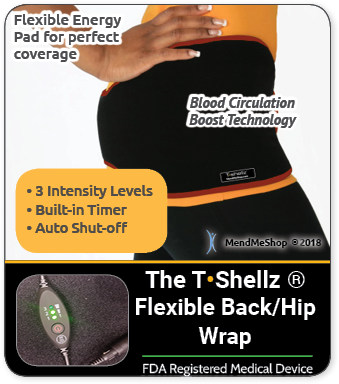|
| Ice vs Heat for Treating Soft Tissue Injuries of the HipWhat's Better to Treat Your Hip Muscle/Tendon Injury: Ice or Heat?Ice and heat are the best treatment combination for you if:
Combining cold and warmth is a simple yet effective way to get immediate pain relief and promote long-term healing. In your lifetime you've probably had your mom, family doctor, nurse, surgeon or physical therapist tell you to use ice right after you're injured and something warm from time to time once the swelling's gone down. It's a simple yet very effective way to relieve pain and promote healing in your hip or lower back. Hip injuries can happen to anyone, and right now there are thousands of doctors and physical therapists dealing with patients that require a solution to their soft tissue injury fast and heal it (where possible). If you want to be proactive about properly dealing with your bad hip, speak to your doctor about adding conservative temperature treatments to your recovery with MendMyHip's system using a Cold Compress or Ice Pack and Circulation Boost with a Back-Hip TShellz Wrap. Note: If you have an Acute (recent, inflamed) Soft Tissue Injury, Do Not Use Heat.Your doctor knows that the sooner cold is applied, the quicker you can reduce inflammation and achieve real pain relief. This will help reduce the chance of a much longer lasting chronic injury. Heat and inflammation are a bad mix and should not be used together. Heat is good at the spa - it will help your body relax, but when it comes to an injury it is not a good idea (unless your physician specifically recommends otherwise). When To Use Cold:A Cold Compress or Ice Pack work best to relieve pain, swelling and inflammation for new injuries, re-injury and during immediate post surgery recovery. A Cold Compress or Ice Pack should also be used during the first 24 - 72 hours of treatment, combined with resting your injury. Generally speaking, cold is recommended:
When to use a Back/Hip TShellz Wrap® (HEAT):
Here Is An Example For When To Use Cold (Ice) Or Heat:You Have Been Dealing With A Strained Muscle In Your Hip For Over 5 Months.You haven't felt any pain in the area for the last week now, so you decide to head out for a 10 minute walk to get some fresh air. You realize near the end of the walk that the familiar pain is back and you are limping. Use COLD on your hip to stop further damage to the micro tearing in your hip muscle and help ease the inflammation and pain. Before getting active next time, do light stretches and apply a Back/Hip TShellz Wrap® treatment to the affected area 30 minutes to 1 hour before undergoing the strenuous activity. It will help limber up the area temporarily and lower the risk of re-straining the injury during this period. You Occasionally Feel Sharp Pains In Your Inner Thigh (Groin) That Shoot Down From Your Hip.You're not sure if you have an injury, but this pain seems to come and go only when you do a lot of walking, exercising or any twisting / pivoting on your leg. When you feel the sharp pain, the pain will continue to radiate in your groin for a few hours after and your leg feels weak. Go See You Doctor to Get a Proper Diagnosis. Use a Cold Compress or Ice Pack as needed to reduce the radiating pain and any potential inflammation. If you feel like the area is tightening up, use the TShellz Wrap® treatment when getting up in the morning or before undertaking activity. Use cold after any sort of activity causes you on-going pain.When Should You Use A Back/Hip TShellz Wrap® For Your Hip?TShellz Wrap® treatments work best to increase blood flow circulation and relieve pain for older (chronic) injuries, re-injuries (after swelling has been reduced) and during long-term post surgery recovery. TShellz Wrap® should not be used directly after an injury, as you must wait for swelling to drop. TShellz Wrap® treatments should not be started for a least 2 weeks after surgery because inflammation levels will be very high as the healing process starts over again. Any use of a TShellz Wrap® should also be combined with gradual movement to stretch out your hips and increase range of motion. If you have a chronic hip injury that keeps getting re-injured or muscle spasms in the lower back, glutes, hips, abs, or thighs you should use a Back-Hip TShellz Wrap before activity to loosen up soft tissue (making it more flexible). This treatment is shown to increase the elasticity (flexibility) of the soft tissue in and around the treatment area, making it more pliable for activity and less likely to re-injure. Sometimes we feel pain while doing a certain activity - should you still use a TShellz Wrap®? Using a TShellz Wrap in the morning before you start your day or before activity can help to boost blood-flow and reduce risk of further strain or injury. Use cold part-way through your day after you have been active so you can decrease pain and inflammation from the flare up. Using a Back-Hip TShellz Wrap® is a good long-term plan because it will help stimulate blood flow (vasodilation) and can also be used on a preventive basis to relax constricted soft tissue (increased elongation & flexibility of muscles, ligaments and tendons). The use of a TShellz Wrap® indirectly enhances the local blood circulatory system, increasing the flow of nutrients your soft tissue needs to heal - oxygen, nutrients, anti-bodies and energy. What Makes the Back/Hip TShellz Wrap Different?With regular use of the Back/Hip TShellz Wrap:
Our high quality wraps are registered with the FDA as medical devices which meet high manufacturing standards. How to Use Ice and Heat to Relieve & Treat Your Hip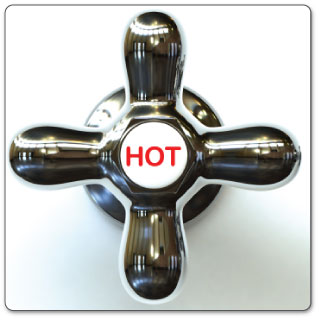 The most common soft tissue hip injuries are debilitating. At a minimum, they will impede your ability to extend and contract your hip joint. Being unable to move your legs in these ways will majorly interfere with everyday tasks like getting dressed, driving, working or reaching for anything. When it comes to using ice and heat for treating a bad hip, it's important to keep in mind that both ice AND heat are very effective natural ways to relieve pain and heal. Most people will think one is better over the other from their own experience or what a doctor / physical therapist has previously told them specific to a previous treatment plan. The only difference between using ice and heat is that 1 is better for you at a specific time in your healing cycle. Ice is used first, right when you get your injury, to decrease pain / swelling and inflammation. Once swelling has reduced, we then focus on heat based treatments to increase blood flow circulation in the area to stimulate the body's healing response. 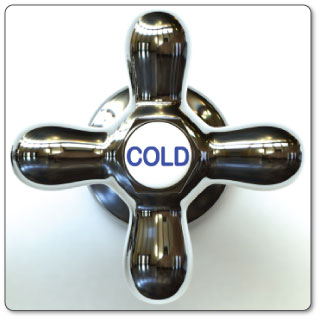 Each temperature applicaion has its own unique benefits for the hip (or any soft tissue really), and when used together, they provide a powerful advantage to long-term soft tissue health. You may already know that ice or heat feels better on your hip, and this could influence your decision too. The bottom line is that ice and heat are exceptional, natural pain relievers and healers for soft tissue injuries. When we say soft tissue, we are talking about muscles, tendons, ligaments, cartilage and bursas. There are cases where some hip injuries will respond better to 1 temperature over the other. We want to help clear up the confusion so you know which is better (icy cold or gentle heat) and how to get the most from your treatment at home. How Do You Use Ice / Cold as Pain Relief for Your Hip Injury?COLD (ice) is used to treat injuries or conditions that are red, hot, inflamed, swollen and suffering from tissue damage (a tear or recovering from surgery). Cold is a natural / organic pain reliever that numbs pain right at the source of your injury. While doing this, the cold also stops cellular break-down and reduces the amount of scar tissue forming (this is very important after surgery). When cold is applied to a hip injury, soft tissue in the hip will constrict and squeeze on the blood vessels to slow down your blood flow. This in turn clamps down on the amount of fluid leaking into your injured tissue, decreasing swelling. This is why cold is used immediately to treat acute (recent) injuries or re-injuries - basically, newly damaged soft tissue. The cold slows down your body to reduce the amount of damage happening to soft tissue and decrease the swelling. This cold also has a nice side benefit of numbing nerves in and around your hip, further decreasing your pain. In the medical world this is something called 'Vasoconstriction'. Cold can Make Your Soft Tissue Injury Worse - How? Applying cold can restrict blood flow and stiffen / tighten soft tissue. Cold is NOT a good treatment method for soft tissue tears or strains when the tissue is already tight and constricted, because the cold will just stiffen the tissue further. Instead, use a treatment option that will increase blood flow, like the Back/Hip TShellz Wrap® to relieve tightened and constricted muscles Circulatory Boost used at this time will help relax / elongate soft tissue, making it much more pliable for activity. When to Use a Cold Compress or Ice Pack to Treat Your HipCold compression works best to relieve pain, swelling and inflammation for new injuries, re-injury and during immediate post surgery recovery. Cold should also be used during the first 24 - 72 hours of treatment, combined with resting your injury. If you've been suffering for some time with a chronic hip injury you should only use cold after activity causes you more pain or your body is showing more inflammatory response symptoms (red, hot, inflamed, swollen). This would be when your hip, outer thigh or lower back starts to hurt at the end of the day after you've been on your feet throughout the day. When used at this time cold compression becomes a natural / organic pain reliever, targeting the localized site where you feel the pain. Sometimes we feel pain while doing a certain activity - should you still use cold? Too much cold can reduce your ability to heal correctly, because cold is a short term pain reliever, not a deep tissue healer. Cold Compression slows nerve and cell function - reducing swelling that blocks blood vessels from doing their job. This is important because once blood vessels are blocked or damaged, they can no longer carry oxygenated blood through the tissue and tissue begin to break-down. Without a cold temperature treatment, tissue damage and break-down continue as they cannot get the oxygen they need to survive. By limiting the amount of damage done to your hip, you also reduce the amount of healing that needs to occur. This is an important step to heal hip joint injuries faster and with less pain! How Do You Use a Back/Hip TShellz Wrap® (Heat) For Your Hip?HEAT (warmth) is used after you've reduced your swelling / inflammation and the sharp pain is less intense (you have more of a dull / nagging ache and soft tissue tightness in your hip). Warming up your tissue is a natural way to encourage blood flow to muscles, tendons and ligaments. Increasing the temperature of soft tissue will result in increased blood flow circulation as the body sends more blood there to attempt to remove this same heat. It's the blood in your body that will bring oxygen, nutrients and water (basically energy) to your injured hip to help with healing. When heat is applied to the hip, veins and blood vessels will start to get bigger (expand) to allow more blood flow through to your damaged or torn soft tissue. This in turn relaxes your hip, making the tissue more flexible and elastic. This is why heat is used on older (chronic) injuries, to loosen tissue and bring in the blood flow needed for soft tissue to repair. Your body will begin to heal itself after it is injured - increasing your blood flow with heat will, in most cases, speed up this natural process - often surprisingly well. Doctors usually call this process 'Vasodilation'. Heat can Make Inflammation, Swelling and Newer Injuries Worse - How? When we injure ourselves, we start healing right away. The body will naturally raise the temperature at the site of the injury resulting in the inflammatory response (redness, heat sensation, inflammation and swelling). This 'fake fever' leaks blood flow to the area to cool it down and start the healing process. Adding 'heat' to your hip when it's already inflamed and tender may make your body think there's a new threat to your tissue and increase the pain in order to get you to stop. For some people applying heat on inflamed / swollen tissue will cause the injury to swell-up even more (as much as 3 times larger than normal). You'll feel even more pain as the pressure builds in your hip. Heat is NOT a good treatment method for inflamed soft tissue, new injuries (within the first 24 to 72 hours), right after surgery or right after a re-injury (over-use and/or sharp, throbbing pain). In these cases, heat should be applied later on in the healing cycle once swelling has calmed down substantially. In the meantime, use a Cold Compress or Ice Pack to decrease any inflammation induced pain. When To Use Heat to Help Your HipThe primary intent of a heat based application is to increase blood flow circulation and, as such, stimulate the body's recovery rate for older (chronic) or recent (acute) injuries, long-term post surgery recovery and more recently - for some regenerative therapies performed by doctors and pts. Warmer temperatures should be used approximately 3 to 5 days after you first have the injury or even later if the swelling has not reduced significantly. Heat should not be started for a least 2 weeks after surgery because inflammation levels will be very high as the healing process starts over again. Any use of heat should also be combined with gradual movement to stretch out your hip and increase range of motion. If you have a chronic hip injury that keeps getting re-injured you should use heat before activity to loosen up your tissue (making it more flexible). When used at this time the warm temperatures naturally extend the elasticity (elastic-nature) of the joint, making it more movable / pliable for activity. Sometimes we feel pain while doing a certain activity - should you still use heat? Using heat in the morning before you start your day or before activity can help to boost the healing process and reduce your risk of re-injury. Too much heat (especially when you suffer a set-back with swelling / inflammation) can make your inflammation worse. Cold treatments with a Cold Compress or Ice Pack should be used part-way through your day when you suffer from on-going pain and inflammation - it is a natural pain-reliever. Using heat is a good long-term plan because it can be used on a preventive basis to relax constricted soft tissue. Heat will increase the volume of blood circulation, which in turn, brings all the components your body needs to heal more efficiently - oxygen, nutrients, anti-bodies and energy. Keep using heat before activity and when you notice any stiffness in your hip to 'warm up' your muscles, tendons & ligaments - this will help them stretch further during activity and help reduce risk of further tearing.How to Use Consistent Deep Hip Stretching for Improved Hip Flexibility & Health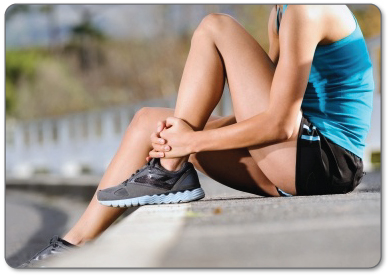 For many people, the treatment doesn't just end with Heat and/or Cold applications. Stretching is plays an important part in hip soft tissue recovery - and it's the final step needed when healing your injury with conservative treatment methods. You would be surprised by how many people there are that don't understand the importance of stretching a deep tissue hip injury. Before returning to full activity after a hip injury, PTs prescribe gentle stretching of the affected area... This is because stretching an important part in recovery from any soft tissue injury. Consistent stretching is one of few solutions available to break up scar tissue that forms on your hip as it heals. Stretching with use of a Cold Compress or Ice Pack and TShellz Wrap® is even better! Stretching your hip is even more powerful |
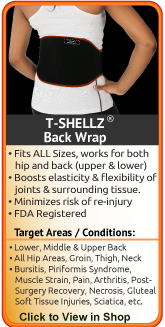       |


